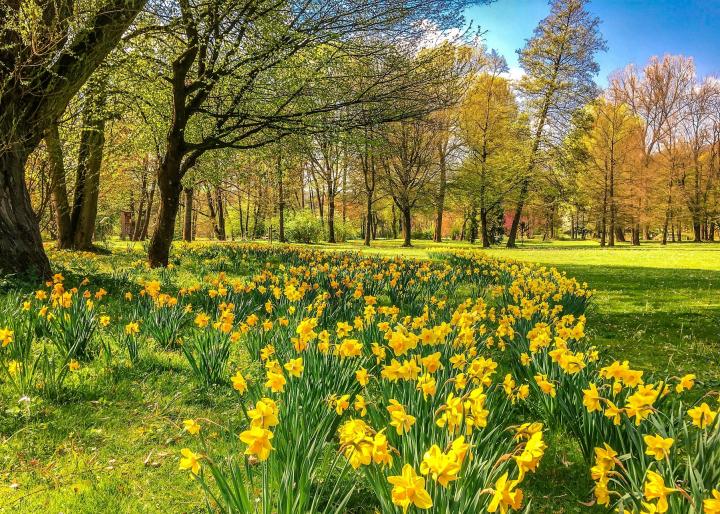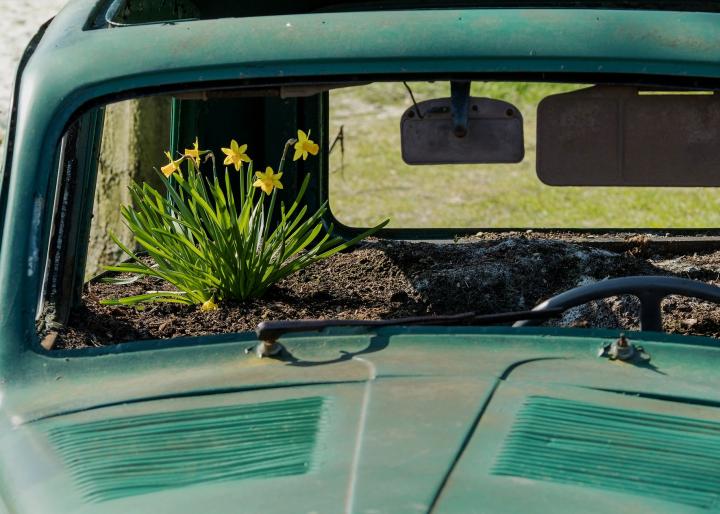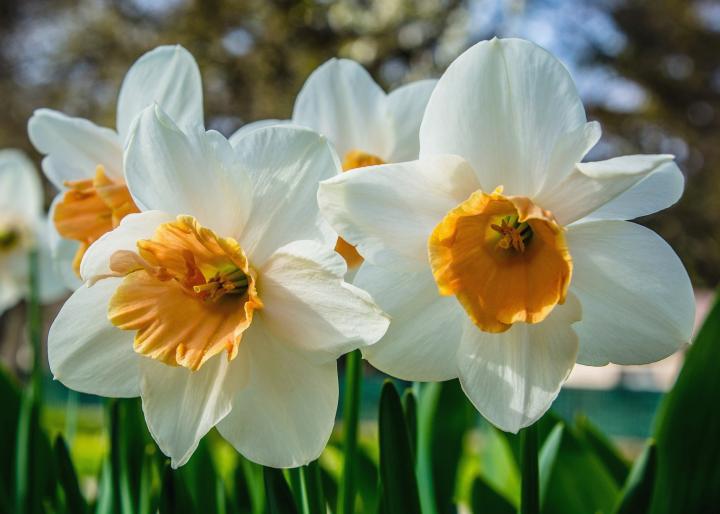Daffodils are one of the earliest spring-blooming flowers! Find all our tips on planting daffodil bulbs, caring for daffodils, and what to do after they flower.
About Daffodils
Daffodils are a hardy and easy perennial that grows in most regions of North America, except in the hottest, wettest areas, such as South Florida. Daffodils are a fall-planted bulb, so plant them in autumn and they will bloom in late winter or early spring. (They are the March birth flower, after all!)
The traditional daffodil flower may be a showy yellow or white, with six petals and a trumpet-shape central corona, but many cultivated varieties (“cultivars”) exist today. Leafless stems bear between 1 and 20 flowers; sometimes the flowers need to be staked so that they don’t weigh down the stems.
Daffodils are suitable for planting between shrubs or in a border, or for forcing blooms indoors. They look wonderful in a woodland garden and in large groves. You’ll find that many gardeners plant the bulbs not just by the dozens but by the hundreds! Daffodil flowers also make for great springtime cut flowers.
When to Plant Daffodils
- Plant daffodil bulbs in the fall—about 2 to 4 weeks before the ground freezes. See local frost dates and get more tips on planting fall bulbs.
Choosing and Preparing a Planting Site
- Select a site that offers full sun or partial sun, at the least. Daffodils will bloom best when given adequate exposure to early spring sunshine!
- Most daffodils tolerate a range of soils but grow best in moderately fertile, well-drained soil that is kept moist during the growing season. They are susceptible to rot when kept too wet, so make sure that you plant them in a well-draining spot.
- Many of the popular species prefer neutral to acidic soils, but some prefer slightly alkaline soils, so consult the supplier of your bulbs to see which is best for your daffodil variety.
- Over time, daffodils will produce new, “daughter” bulbs that are attached to the main bulb which you planted originally. This results in nice little clumps of daffodils that stay relatively contained to where you planted them.
How to Plant Daffodils
- Select high-quality daffodil bulbs that have not been dried out. The larger the bulb, the better.
- Plant with the top or pointy end up about 2 to 3 times as as deep as the bulb is high. For example, the top of a 2″ bulb is at least 4″ deep (measuring from the bottom of the bulb) while a 3-inch long bulb should be planted 5 inches deep.
- Daffodils will tolerate some crowding, but they prefer to be spaced about 3 to 6 inches apart.
- It may help to sprinkle a little bulb fertilizer in the hole during planting. Learn more about preparing soil for planting.
- Where winters are severe, make sure there are at least 3 inches of soil covering the bulb.
- Resist the temptation to uncover spring-flowering plants such as daffodils and tulips. You can loosen mulch, but the shoots will still benefit from protection against cold, drying winds in early spring.
- Daffodils contain something called oxalic acid—a substance that makes them unpalatable to most rodent pests. However, if yours are being bothered, consider adding sharp sharp pieces of shells or a pelleted rodent deterrent into and around each planting hole.
- Get more tips for growing bulbs.

How to Grow Daffodils
- Apply a low-nitrogen, high-potash (potassium) fertilizer after flowering if bulbs are not performing as desired. Learn more about preparing soil for planting and soil amendments.
- Water late-flowering daffodils in dry spring weather (flowers may abort in dry conditions).
- Deadhead plants as flowers fade (for neater garden appearance) and allow leaves to remain for at least 6 weeks.
- Lift and divide the clumps when flowering becomes sparse or the clumps congested.
- After daffodils bloom in the spring, allow the plants to grow until they die off. Do NOT cut down earlier. They need time after blooming to store energy in the bulbs for next year’s bloom.
- To remove the dead plants, either snip them off at the base, or twist the leaves while pulling lightly.
- If your daffodils are growing in grassy areas, you can cut the long grass once they’ve died back without affecting their display next year. Be sure to remove all debris so it won’t enrich the grass itself at the expense of next year’s flower display.
- Once daffodils and tulips have gone by, add bonemeal to the soil for next year’s blooms.
- Daffodils are both deer-resistant and rodent-proof, as these animals do not like the taste of the bulbs in the Narcissus family.
- Daffodils can also be toxic to pets, so make sure your animals don’t munch on them.
- The most common problems include large narcissus bulb fly, bulb scale mite, narcissus nematode, slugs, narcissus basal rot and other fungal infections, and viruses.

- ‘Golden Ducat’ is a double daffodil with pure yellow petals. It blooms in mid- to late season and grows 12 to 16 inches tall.
- ‘Petit Four’ is a good choice for a partially shady site. The flower has white petals with a double cup of apricot pink and grows 16 inches tall.
- ‘Rip van Winkle’ is a miniature double daffodil that grows 6 to 8 inches tall and looks great in a grove with many others of its kind.

Using Daffodils as Cut Flowers
- When cut, daffodils should be kept alone in a vase, as their stems secrete a fluid that promotes the wilting of other flowers. If you must combine them, soak them by themselves for as long as possible, then rinse them and add them to the arrangement last. Learn more about keeping cut flowers fresh.
- Note that contact with the sap of daffodils may irritate skin or aggravate skin allergies.
- Daffodils are a March birth flower.
- Daffodils symbolize regard for someone. See more flower meanings.
Here’s some daffodil-themed prose to brighten your day:
Daffodowndilly
She wore her yellow sun-bonnet,
She wore her greenest gown;
She turned to the south wind
And curtsied up and down.
She turned to the sunlight
And shook her yellow head,
And whispered to her neighbor:
“Winter is dead.”
–A.A. Milne, When We Were Very Young
Daffodils,
That come before the swallow dares, and take
The winds of March with beauty.
–William Shakespeare, The Winter’s Tale
I wandered lonely as a cloud
That floats on high o’er vales and hills,
When all at once I saw a crowd,
A host, of golden daffodils;
Beside the lake, beneath the trees,
Fluttering and dancing in the breeze.
–William Wordsworth, I Wander’d Lonely as a Cloud
Of Spring Weather:
Chillier, but daffodillier.
–The 1991 Old Farmer’s Almanac




